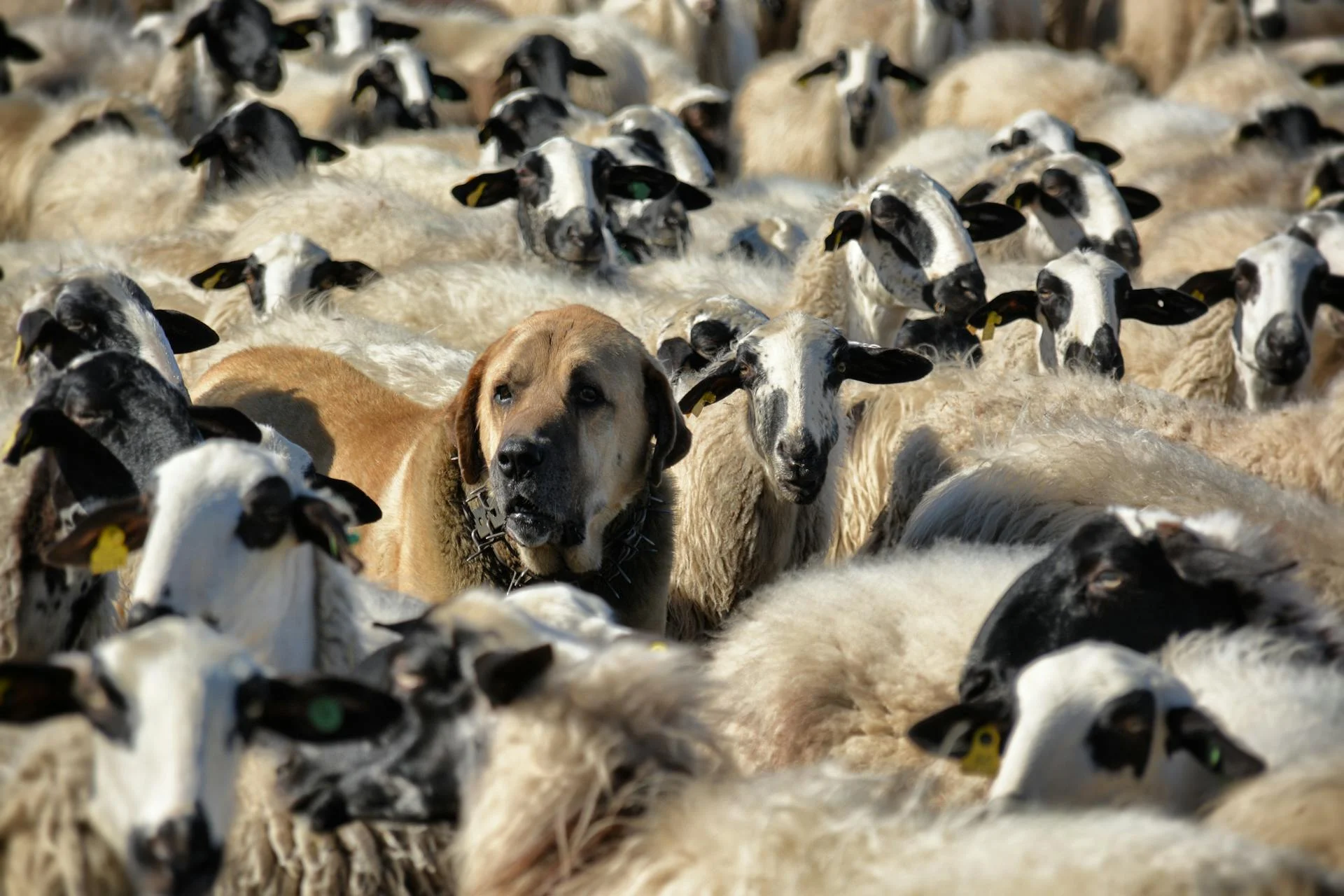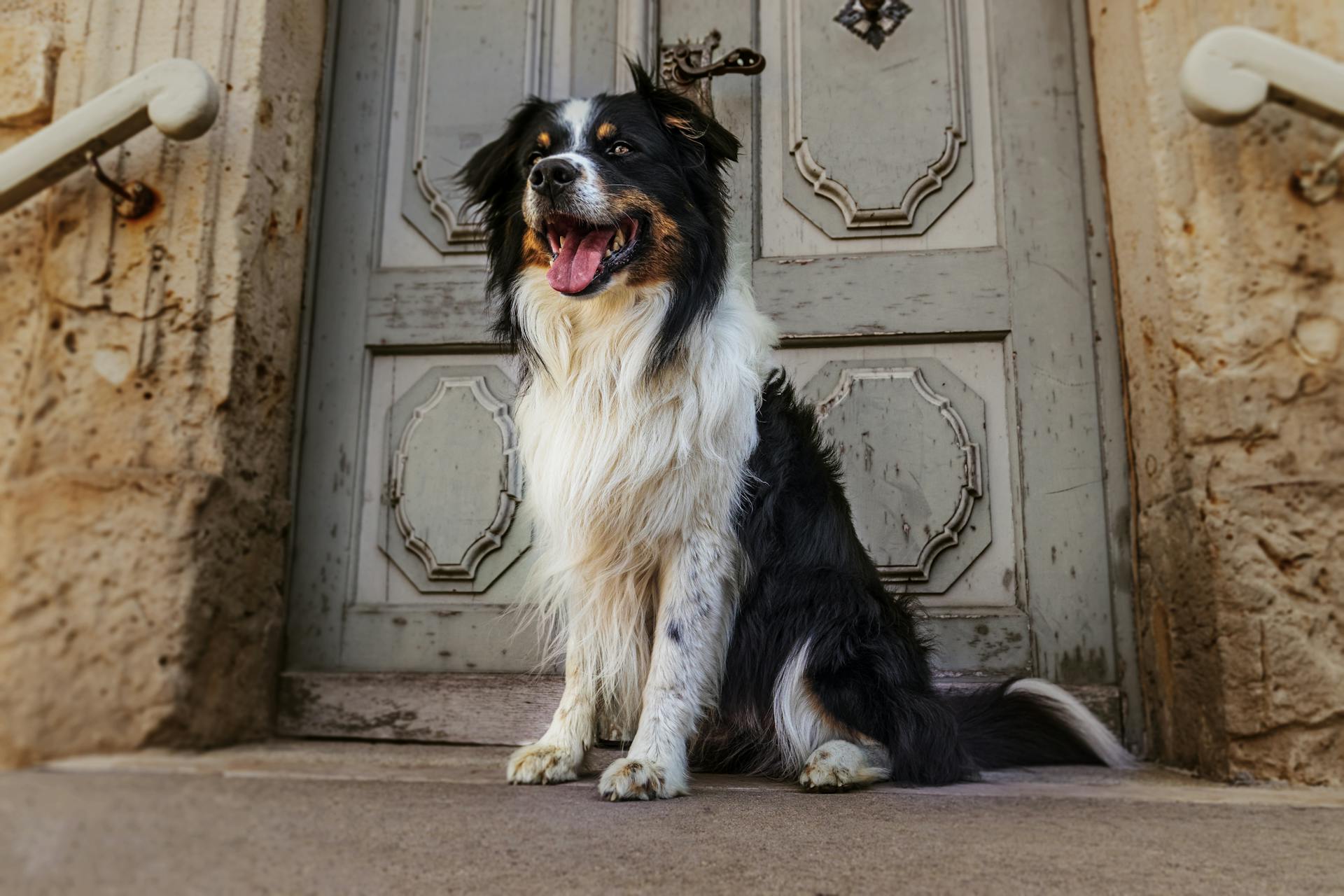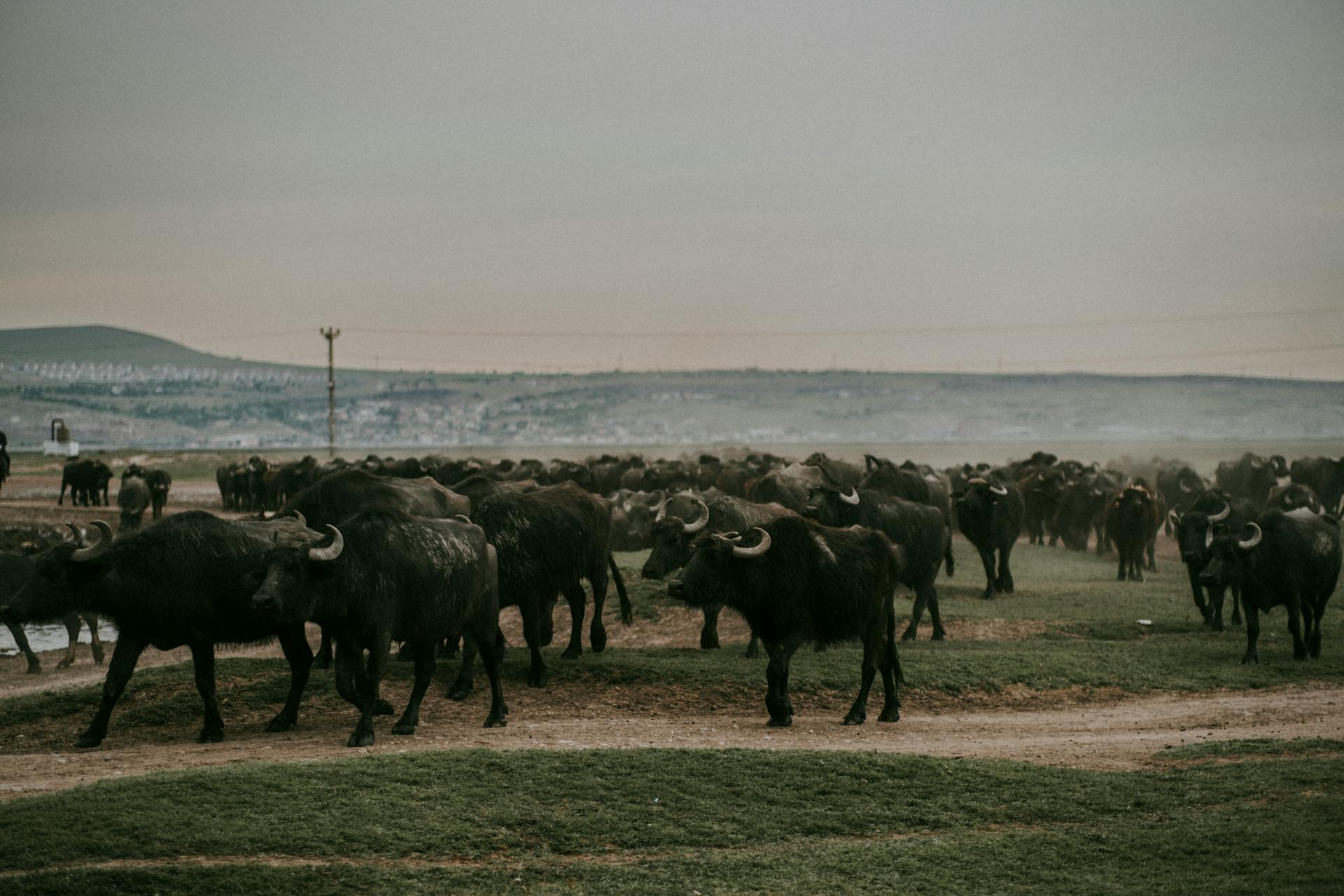
The Anatolian Akbash is a majestic breed with a rich history that dates back thousands of years. They originated in the Anatolian region of Turkey, where they were bred to protect livestock from predators.
These dogs are known for their intelligence and independence, making them a unique breed to work with. They require early socialization and consistent training to become well-behaved companions.
In terms of physical characteristics, the Anatolian Akbash is a large dog with a muscular build, typically weighing between 80 and 150 pounds.
History
The Akbash is an ancient dog breed that dates back to between 750 BC and 300 BC. It's so old that it's said to have aided in the creation of mastiffs and sighthounds.
The breed originated in what is now known as Turkey, where it was bred to protect livestock from predators like wolves. The Akbash is the oldest of the Turkish guardian dogs.
Akbashs were first seen in the plains and mountains of Western Turkey, where they were owned and bred by villagers and shepherds. They were used to guard sheep from predators.
In 2002, a standard was published by the Turkish Standards Institution, and by 2006, the Akbash was recognised by the Ministry of Agriculture and Rural Affairs. This marked an important milestone in the breed's official recognition.
The Akbash arrived in the United States in the 1970s, where it was imported by two Americans, David and Judy Nelson, who became the foundation stock for the breed in the US and Canada. They were later introduced to the US Department of Agriculture's Predator Control Program, where they excelled.
Physical Characteristics
The Akbash is a tall, alert dog with a large white head and a strong jaw.
Its white, weather-resistant double coat helps it survive in cold weather and is coarse but doesn't matt.
This breed combines characteristics from both the Sighthound and the Mastiff breeds, which are thought to have added to its bloodline.
The Akbash tends to inherit the Sighthound's long legs, agility, and pace, as well as the stamina, weight, and height from a Mastiff.
For your interest: Mastiff Anatolian Mix
The double coat is white, medium, or long, and may have grey or biscuit colorings on the head around the ears.
The Akbash's mean body weight is approximately 45 kg (99 lb), and its mean height at the withers is just over 75 kg (165 lb).
There is considerable feathering behind the legs, and the tail is heavily feathered.
Grooming
The Akbash has a double coat that can range from medium to long, requiring weekly brushing to prevent matting.
A sturdy double-sided brush is a good tool for the job, and can help keep your Akbash's coat looking its best.
During shedding seasons, which can occur in spring and fall, your Akbash will blow its coat to prepare for the upcoming weather, and you may need to brush them twice a week to keep up with the shedding.
You'll also want to invest in a good vacuum cleaner, such as a HEPA-rated one, to pick up stray hair that can accumulate on your furniture.
Fortunately, the Akbash's coat has no odor, so you won't need to bathe them too often, and over-bathing can be avoided.
Take a look at this: Are Anatolian Shepherds Good Guard Dogs
Weight and Size
The Akbash is a large dog breed, but it's worth noting that it's more slender and lighter than some other breeds. Males can grow up to 32 inches in height.
Here are the average height and weight ranges for Akbash dogs:
- Males height: 28–32 inches (71–81cm)
- Females height: 27–30 inches (69–76cm)
- Males weight: 90–140 lbs (41–64kg)
- Females weight: 75–105 lbs (34–48kg)
Akbash puppies typically weigh around 13 pounds at 7 weeks of age.
Health and Wellness
The Anatolian Akbash is a generally healthy breed, but like all breeds, it's not immune to certain health issues. Hip dysplasia is a common problem, where the ball and socket of the hip joint don't match properly, leading to discomfort and arthritis.
These health issues can be managed with proper care and attention. Regular exercise and a balanced diet can help prevent conditions like bloat, which occurs when a dog's stomach twists due to excessive gas.
If you're considering bringing an Anatolian Akbash into your family, it's essential to be aware of the potential health risks. Some conditions, like cardiomyopathy and hypothyroidism, can be treated with medical intervention.
Here are some common health issues to watch out for:
- Hip dysplasia
- Hypothyroidism
- Gastric torsion (bloat)
- Cardiomyopathy
- Eye problems
Health and Conditions
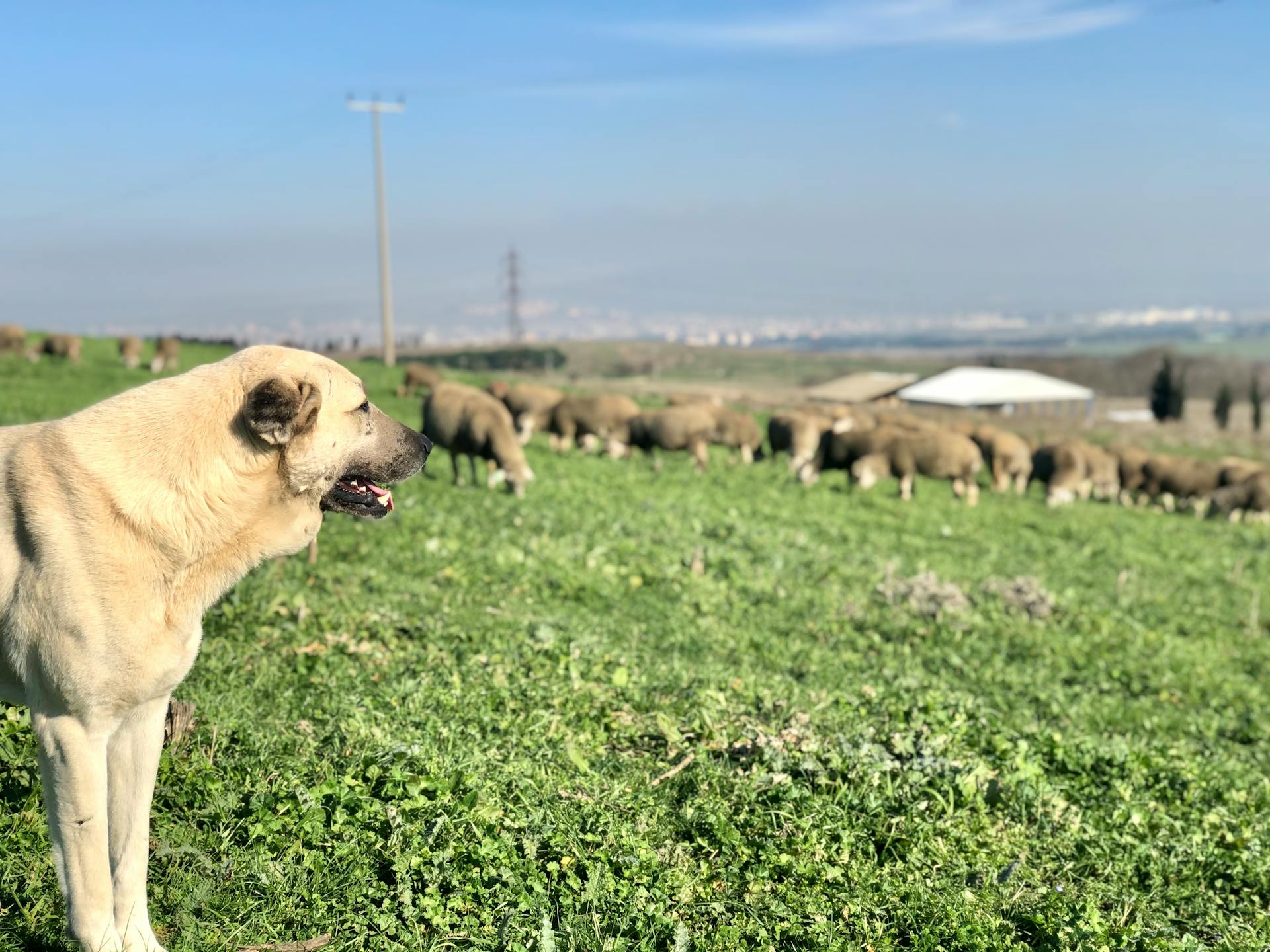
The Akbash is generally a healthy breed with a moderate 10- to 12-year lifespan, but it's essential to be aware of the potential health issues that can arise.
Hip dysplasia is a condition that can cause discomfort and bone disease, particularly in dogs that are prone to excessive movement. This is a significant concern for breeders, as dogs with hip dysplasia should not be used for breeding.
Hypothyroidism is a fairly common condition in dogs, characterized by under-activity of the thyroid gland. Symptoms include lethargy, weight gain, and changes in skin and hair.
Gastric torsion, also known as bloat, is a severe and potentially life-threatening condition that can occur in big dog breeds like the Akbash. It's essential to monitor your dog's eating habits to prevent this condition.
Dilated Cardiomyopathy is a heart condition that affects the cardiac muscle, leading to inadequate blood pressure. This condition requires medical intervention to manage.
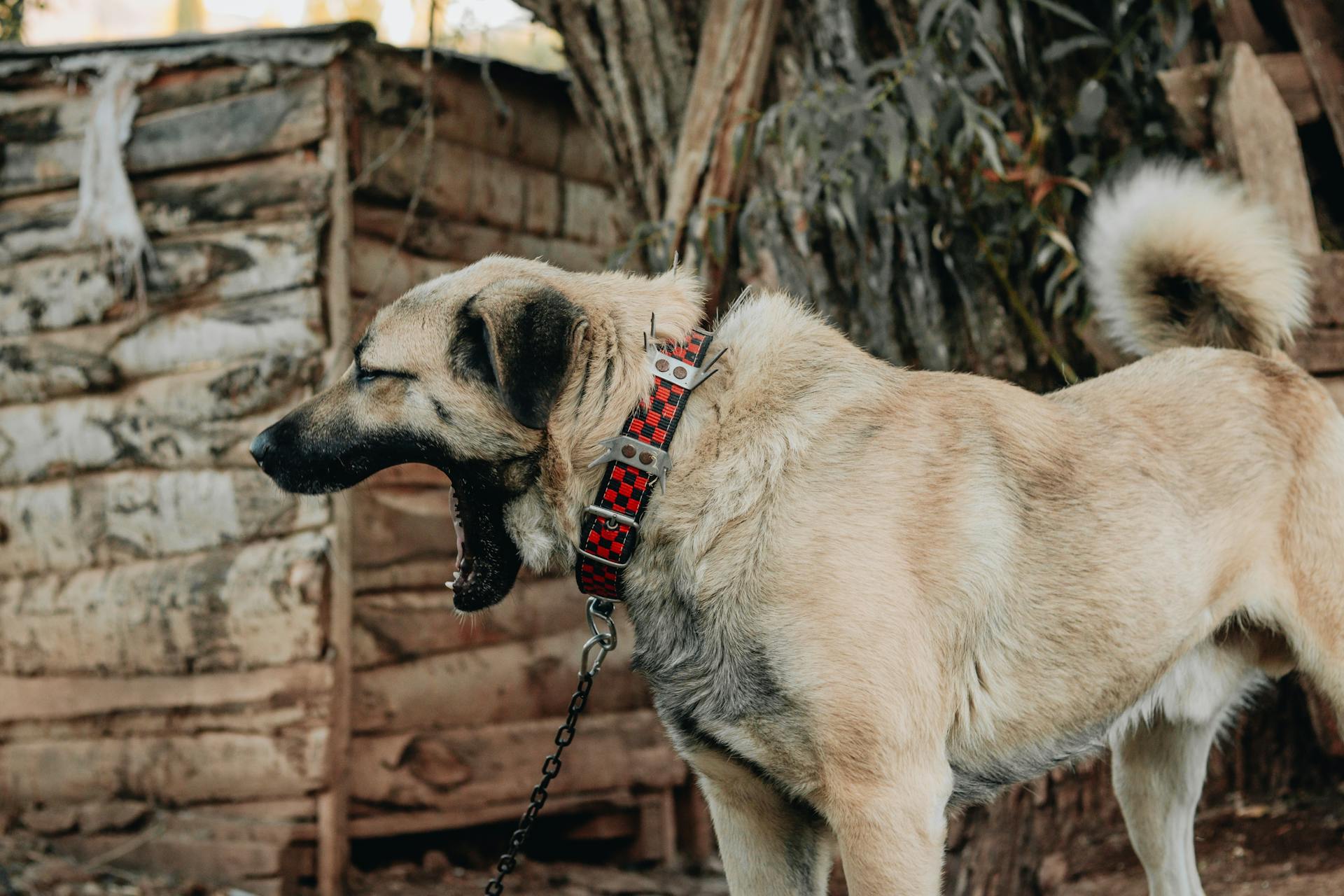
Here are some of the known health conditions that affect the Akbash breed:
Eye problems, such as retinal dystrophy, are also more common in Turkish sheepdogs like the Akbash. Regular eye check-ups can help detect any potential issues early on.
Food & Diet
Akbash dogs are quite particular about their diet, and they thrive on high-quality nutrition.
A moderate protein intake of 22% to 28% is ideal for Akbash dogs, but puppies may need up to 32% or more.
Their robust physique and sharp mind demand a diet rich in protein, energy-fueling carbs, healthy fats, vitamins, and trace minerals.
You can provide this by feeding them complete and balanced dry dog food, which is readily available.
Fresh water is essential, so make sure to provide plenty of it throughout the day.
Temperament and Behavior
The Akbash Dog is a cool, peaceful, independent, and steady home companion and guard dog. He can be devoted, gentle, and affectionate with his human family, cats, and other pets, but is instinctively wary of them.
They aren't particularly fond of other same-gender dogs and may choose to be the only pet in the household. This breed has a reputation for being a protector because they really don't like strangers.
Akbash Dogs are intelligent and relatively easy to train, but they require a goal and a willingness to please their owner. With regular socialization and conditioning from an early age, they can become well-behaved family dogs and guardians.
Their greatest joy in life is just spending time with you, and they enjoy playtime but aren't hyperactive. They learn to see kids and other pets as members of the family flock they must protect.
Akbash Dogs are more independent than Velcro breeds and enjoy their own time away from you as well. They have a legendary fearlessness, prodigious strength, and cat-like agility that allows them to drive off the largest of predators.
Temperament & Intelligence
The Akbash Dog is a cool, peaceful, independent, and steady home companion and guard dog. They can be devoted, gentle, and affectionate with their human family, cats, and other pets, but instinctively wary of strangers.
They are intelligent and relatively easy to train as long as they have a goal and are willing to please their owner. With proper training and socialization, they can learn to be polite in public.
Akbash Dogs are bred to be watchful and independent, making them great protectors of their family and flock. They enjoy spending time with their family, but also value their alone time.
They are naturally suspicious of strangers and will voice their displeasure at unexpected arrivals. This breed has a reputation for being a protector because they really don’t like strangers.
Akbash Dogs are more independent than some breeds and enjoy their own time away from their owners. They are not hyperactive and enjoy playtime, but also learn to see kids and other pets as members of the family flock they must protect.
They are not meant for inexperienced dog owners due to their strength and determination. With proper exercise, socialization, and training, they can become well-behaved family dogs and guardians.
Exercise
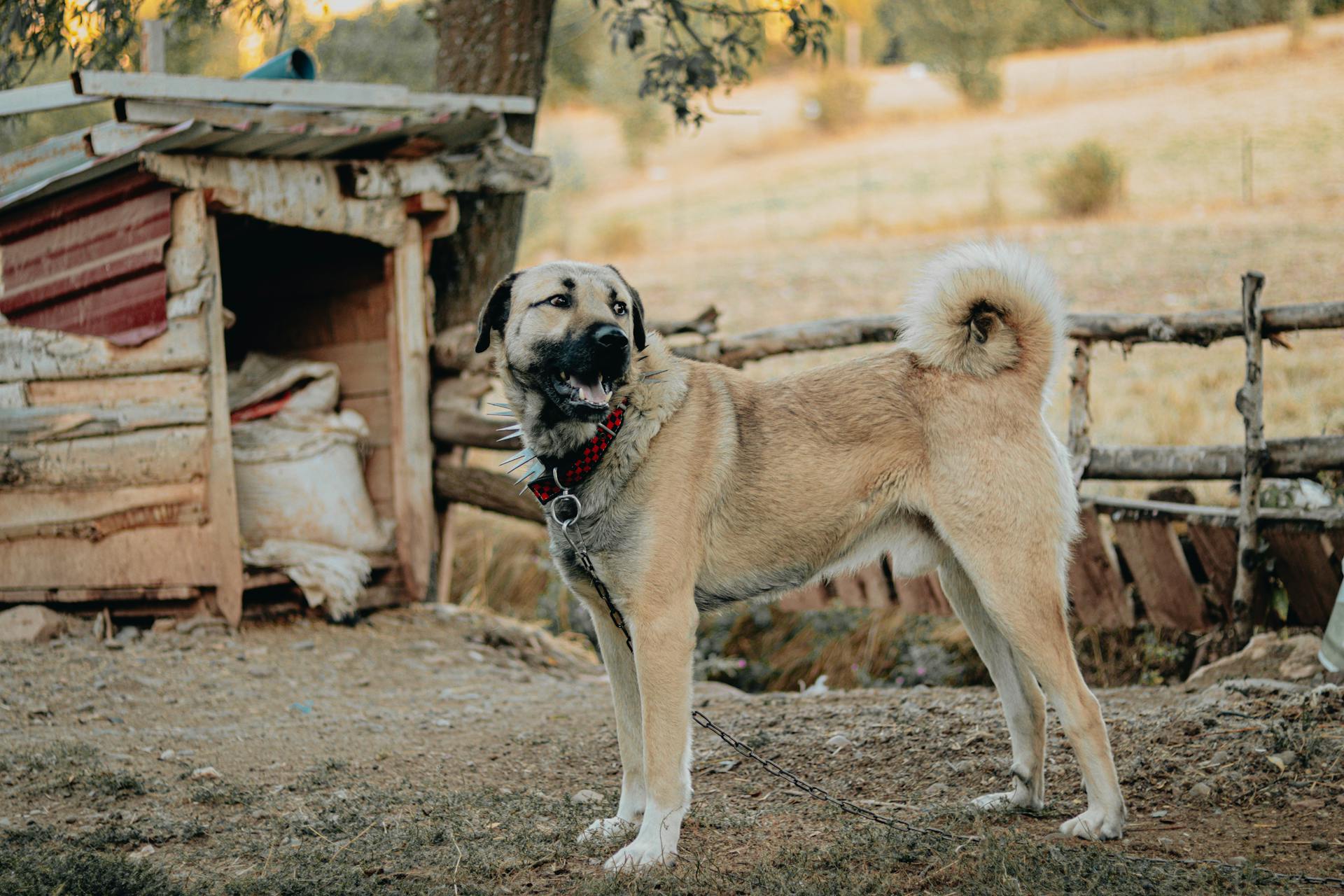
Exercise is a must for Akbash dogs, but don't expect them to need a marathon session every day. Thirty minutes to an hour of exercise is plenty, but it's essential to take it at your dog's pace.
Some Akbash dogs are more inclined to be couch potatoes, while others are more active, so start with short sessions and increase exercise as needed. This will help prevent overexertion and ensure your dog stays happy and healthy.
Frequently Asked Questions
Are Akbash and Anatolian Shepherd the same?
No, Akbash and Anatolian Shepherd are not the same breed, although they share similarities and a common ancestry. The Akbash can be distinguished by its lighter and more slender appearance.
Is an Akbash a good family dog?
Yes, the Akbash is a loyal and gentle breed that makes a great family companion. They are known for being reliable guardians and loving family members.
Is Akbash a Great Pyrenees?
No, the Akbash is not a Great Pyrenees, but rather one of its parent breeds in the Akbash Pyrenees crossbreed. The Akbash Pyrenees is a unique mix of the Akbash and Great Pyrenees breeds.
Are Akbash dogs rare?
Yes, Akbash dogs are a rare breed, particularly in North America. Their limited recognition by kennel clubs contributes to their rarity.
Is Akbash the same as Kangal?
No, the Akbash and Kangal are distinct breeds, despite some similarities. The Akbash is known for its natural protective instincts and bravery, making it a unique breed in its own right.
Featured Images: pexels.com
